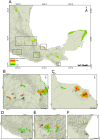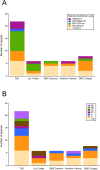Potential risk of Batrachochytrium salamandrivorans in Mexico
- PMID: 30753218
- PMCID: PMC6372179
- DOI: 10.1371/journal.pone.0211960
Potential risk of Batrachochytrium salamandrivorans in Mexico
Abstract
The recent decline in populations of European salamanders caused by the chytrid fungus Batrachochytrium salamandrivorans (Bsal) has generated worldwide concern, as it is a major threat to amphibians. Evaluation of the areas most suitable for the establishment of Bsal combined with analysis of the distribution of salamander species could be used to generate and implement biosecurity measures and protect biodiversity at sites with high salamander diversity. In this study, we identified the areas most suitable for the establishment of Bsal in Mexico. Mexico has the second-highest salamander species diversity in the world; thus, we identified areas moderately to highly suitable for the establishment of Bsal with high salamander diversity as potential hotspots for surveillance. Central and Southern Mexico were identified as high-risk zones, with 13 hotspots where 30% of Mexican salamander species occur, including range-restricted species and endangered species. We propose that these hotspots should be thoroughly monitored for the presence of Bsal to prevent the spread of the pathogen if it is introduced to the country.
Conflict of interest statement
The authors have declared that no competing interests exist.
Figures




References
-
- Skerratt LF, Berger L, Speare R, Cashins S, McDonald KR, Phillott AD, et al. Spread of chytridiomycosis has caused the rapid global decline and extinction of frogs. EcoHealth. 2007; 4 (2): 125 10.1007/s10393-007-0093-5 - DOI
Publication types
MeSH terms
LinkOut - more resources
Full Text Sources

